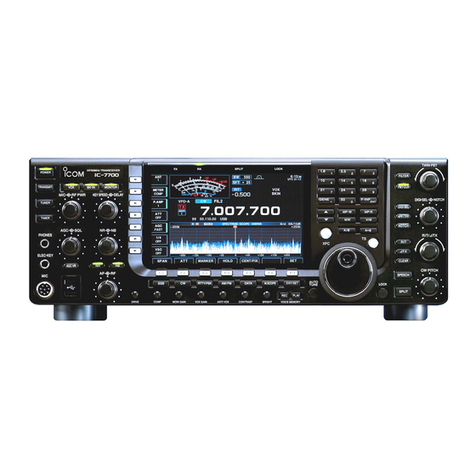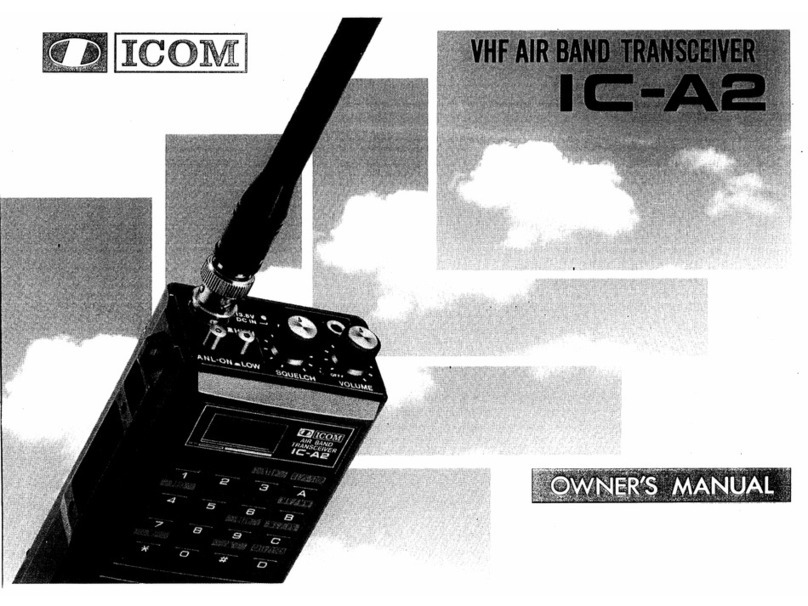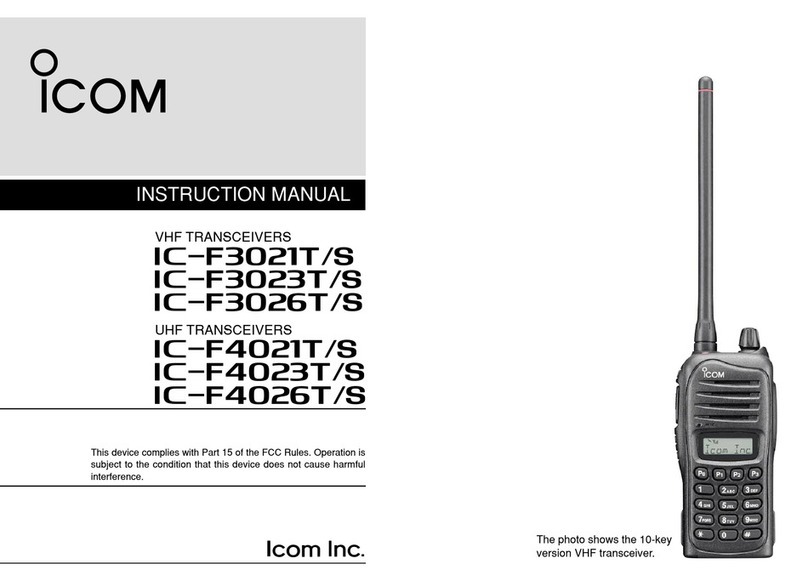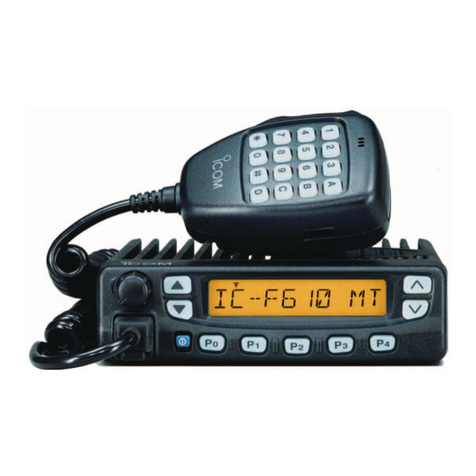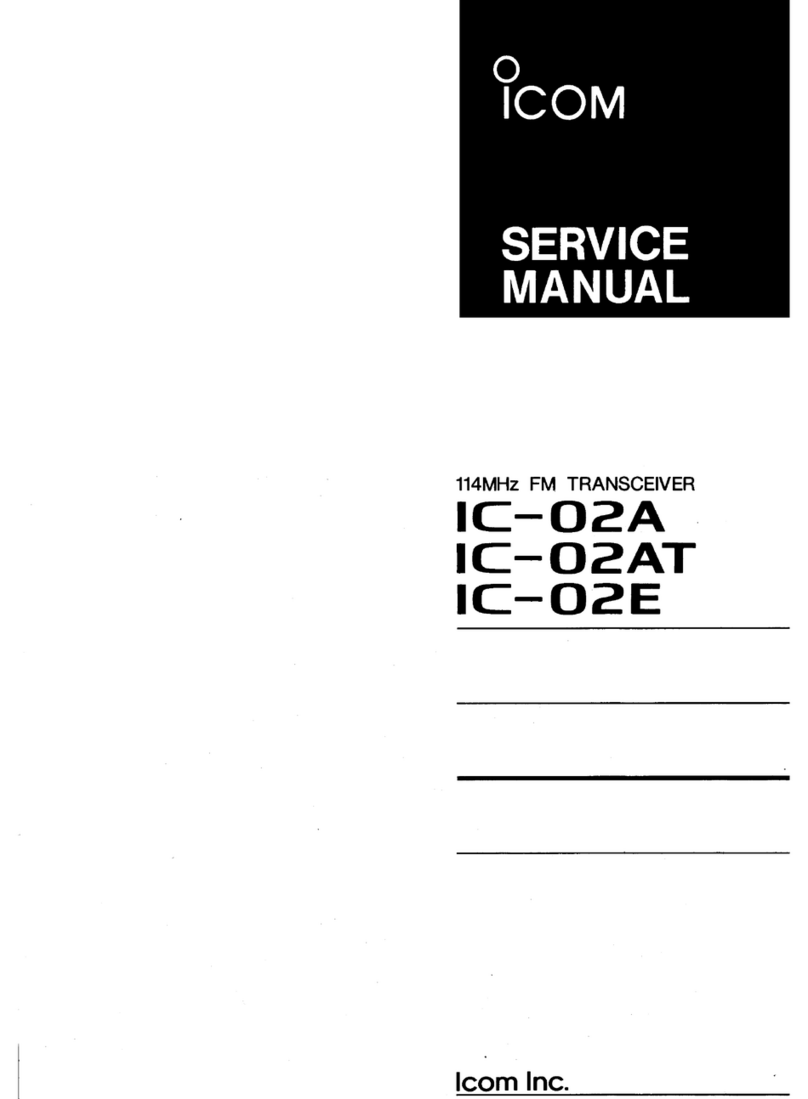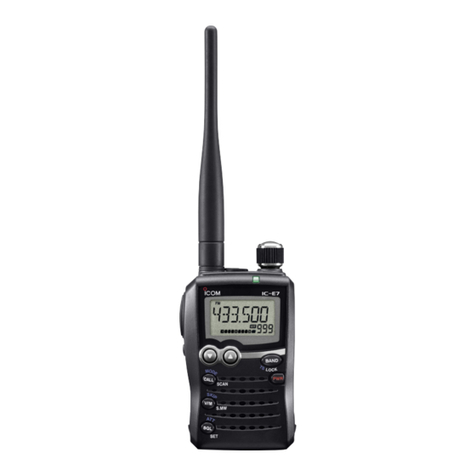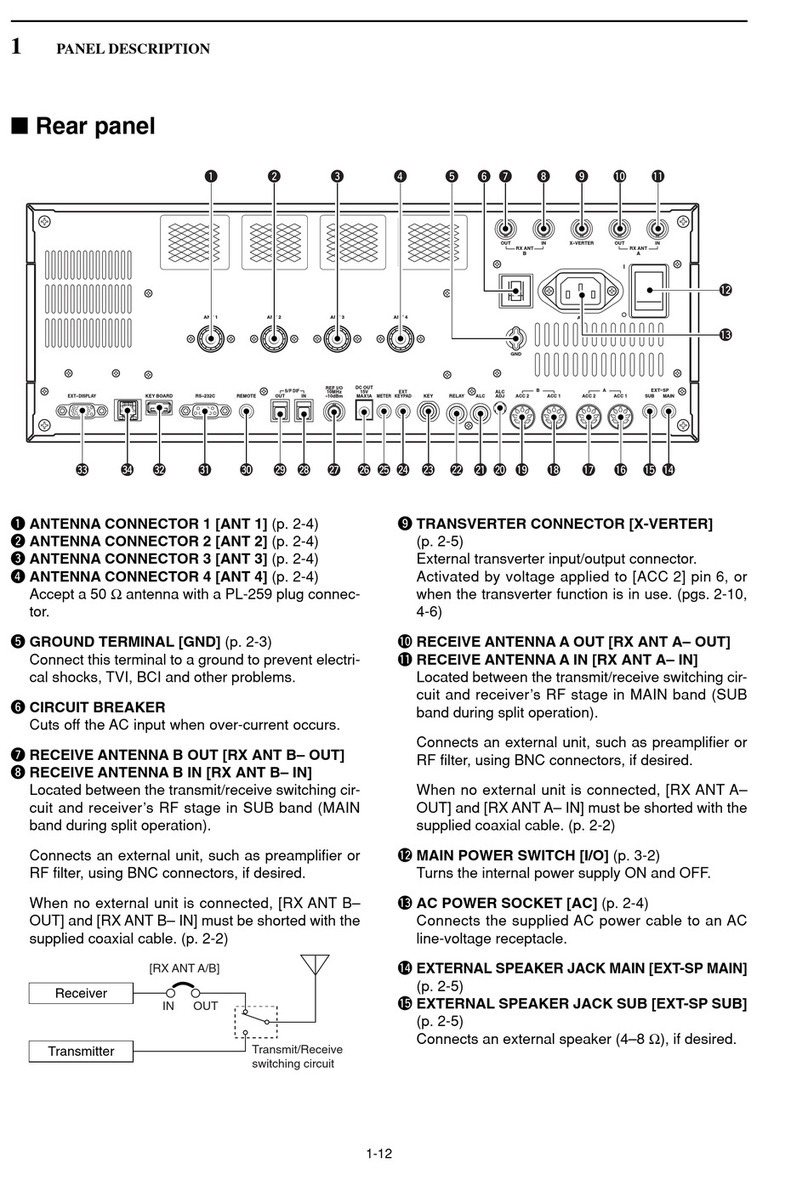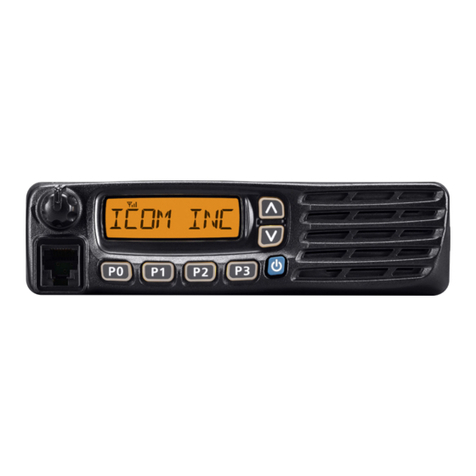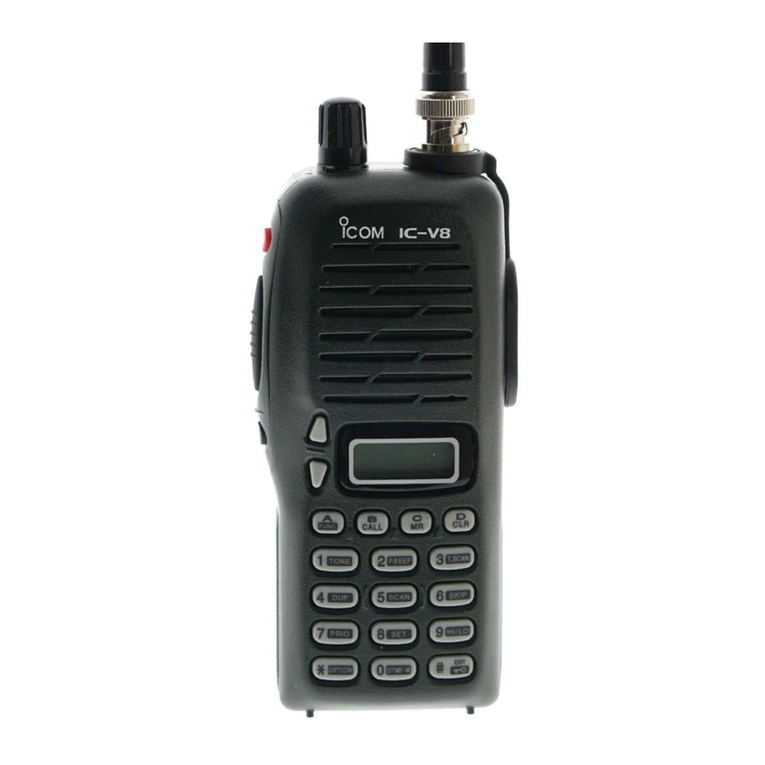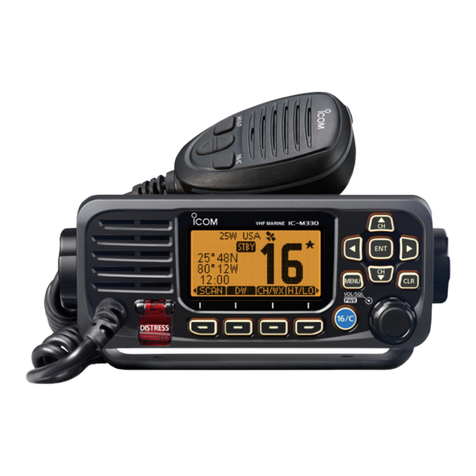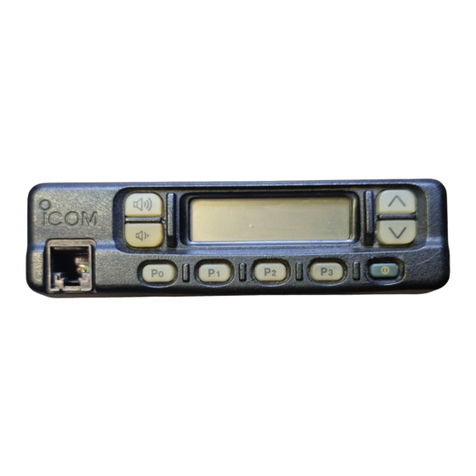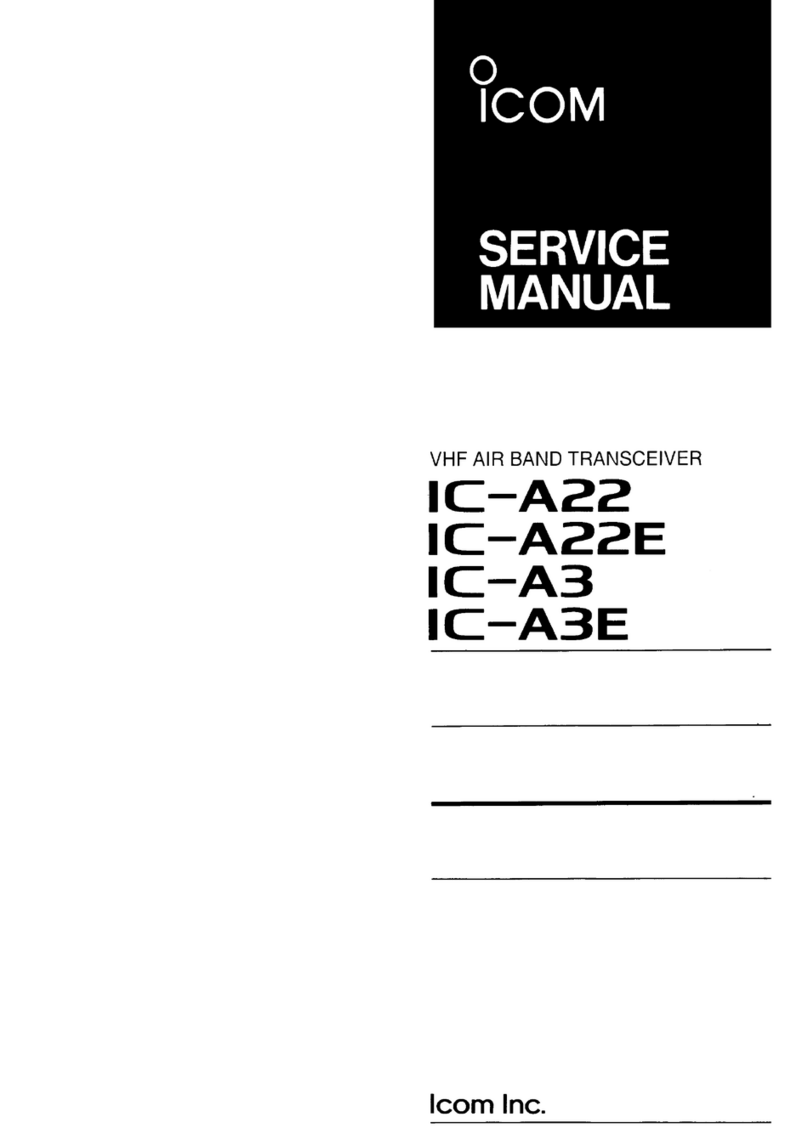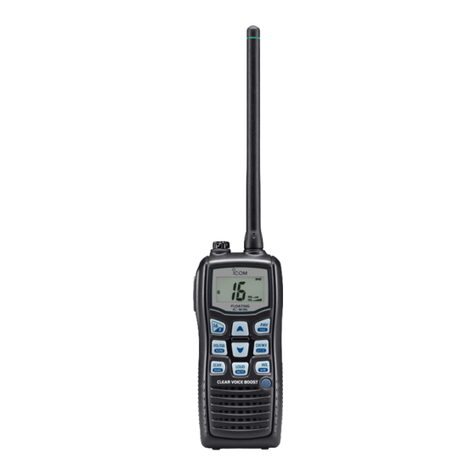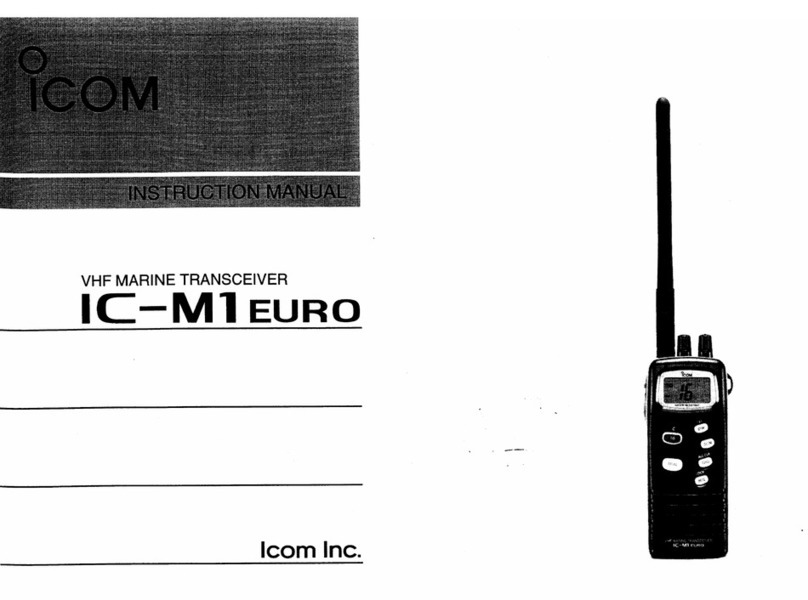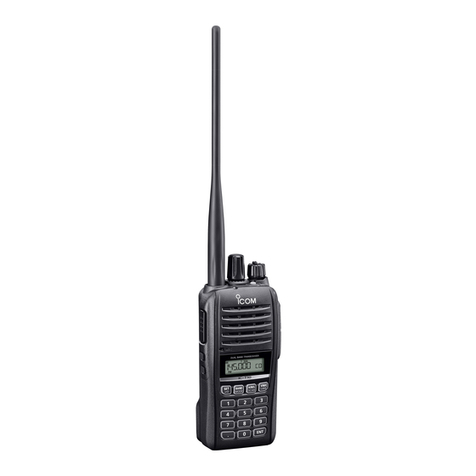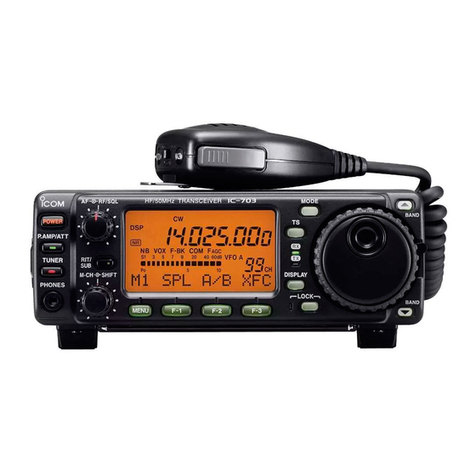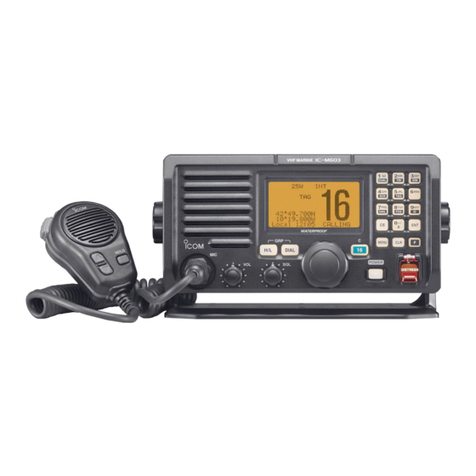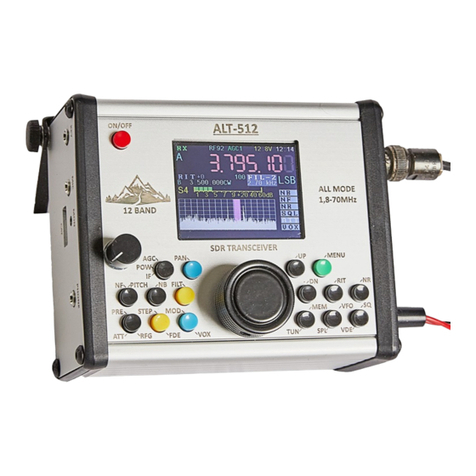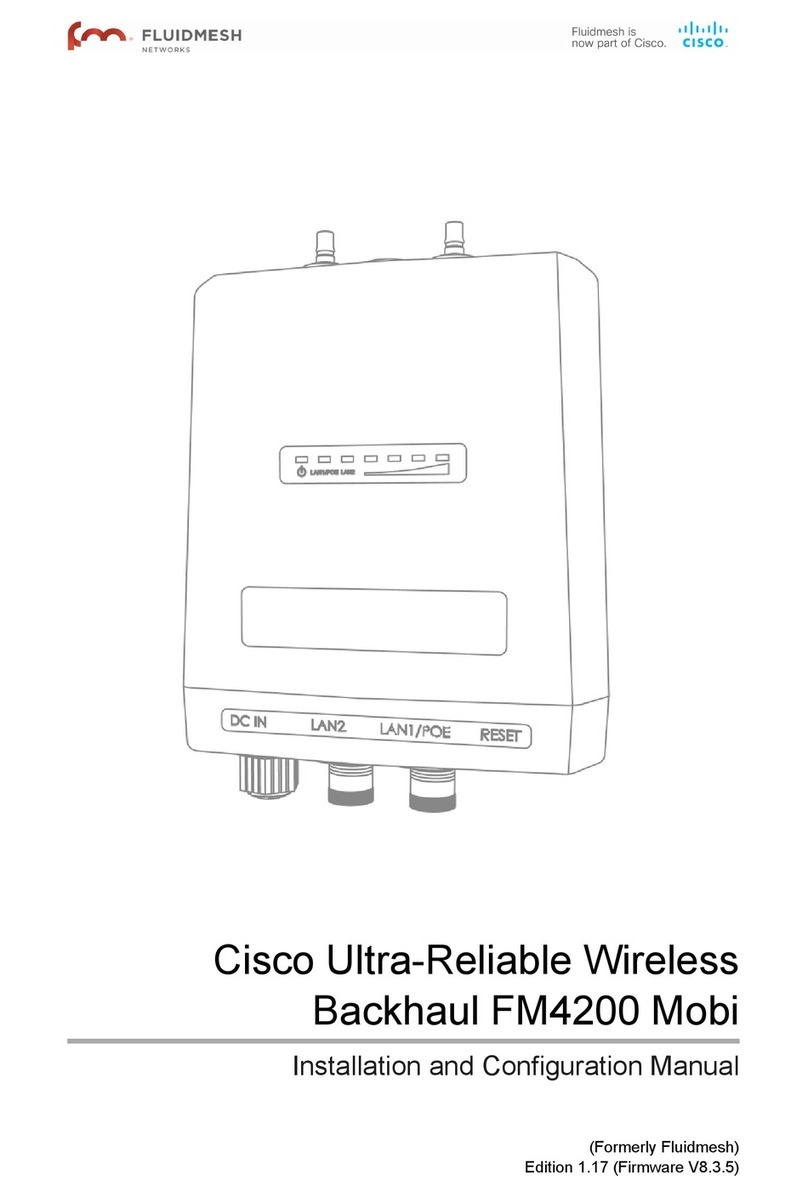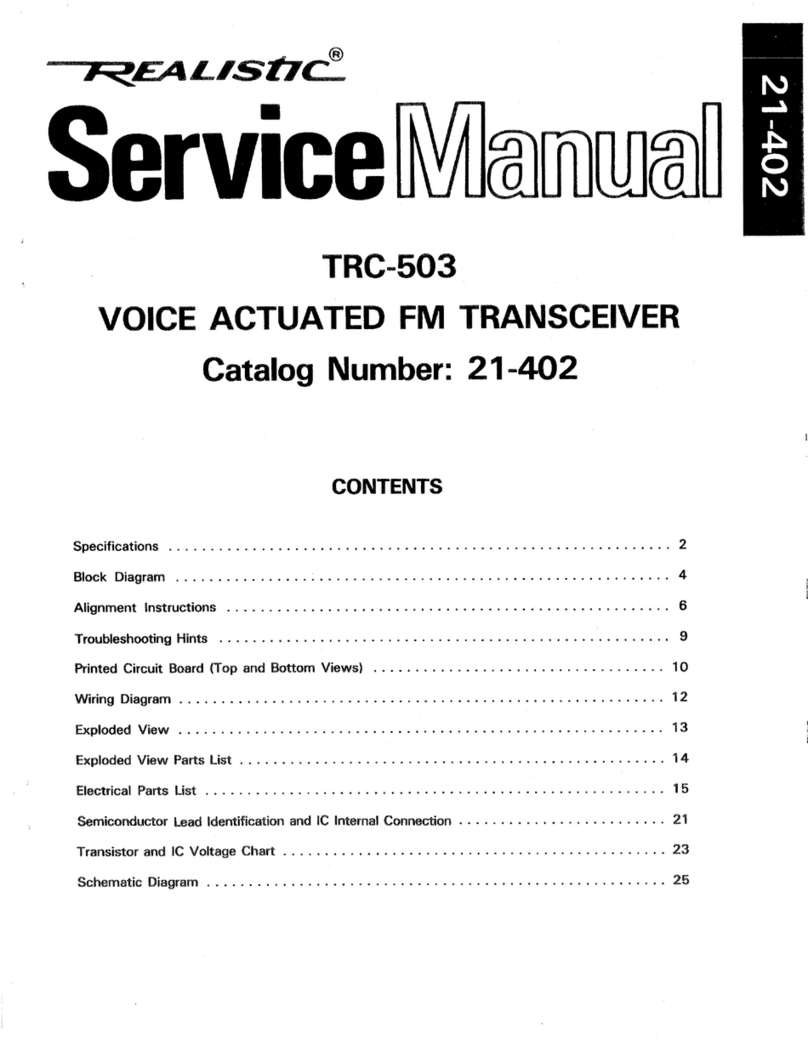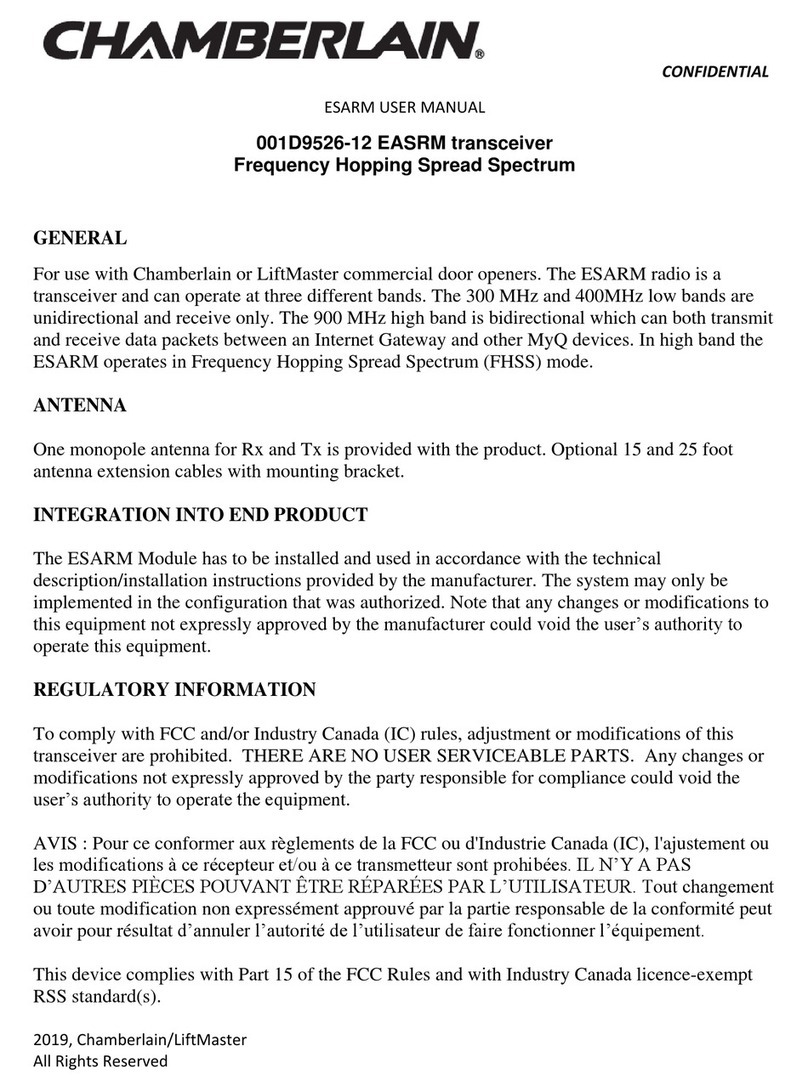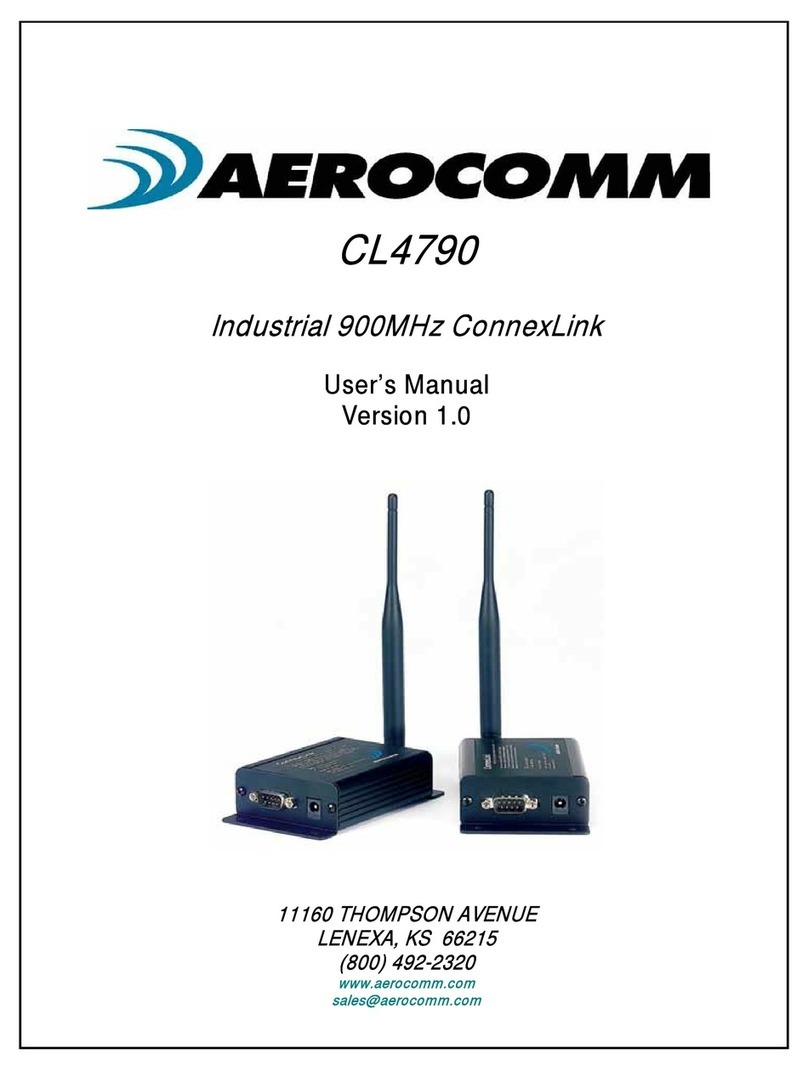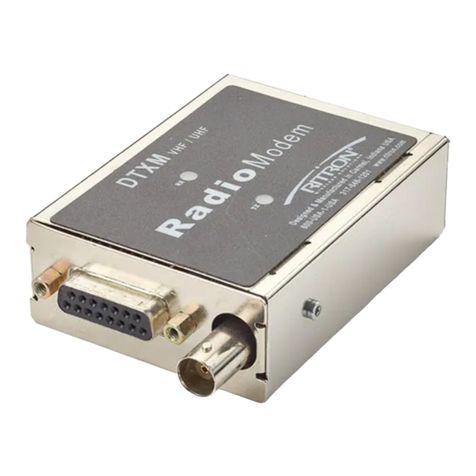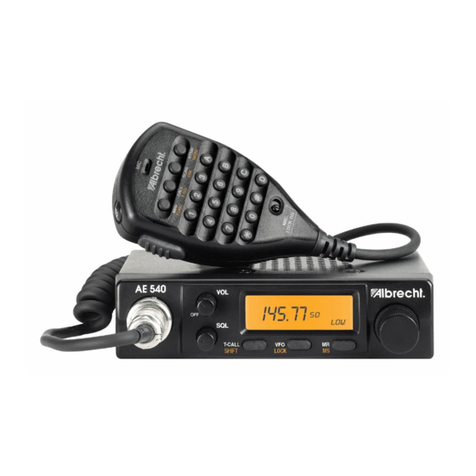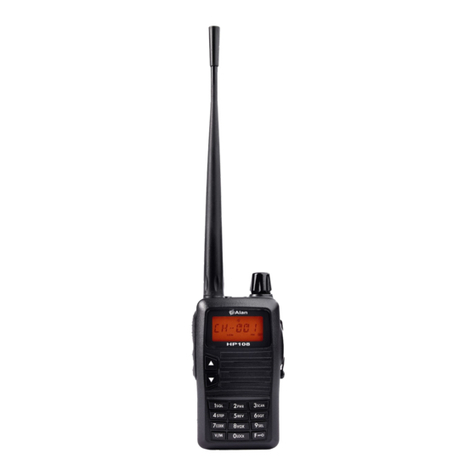Icom IC-U20SR Installation guide

BASIC MANUAL
PMR446 TRANSCEIVER
|U20SR

1
BASIC MANUAL
Thank you for choosing this Icom product.
This product is designed and built with Icom’ s state of the art technology and craftsmanship.
With proper care, this product should provide you with years of trouble-free operation.
■Important
READ ALL INSTRUCTIONS carefully and completely before using the transceiver.
SAVE THIS INSTRUCTION MANUAL — This instruction manual contains important
operating instructions for the IC-U20SR.
This transceiver includes some functions that are usable only when they are preset
by your dealer. The transceiver may have other functions and operations that are not
described in this instruction manual. Ask your dealer for details.
For more information, download the IC-U20SR operating guide from the Icom web site.
(https://www.icomjapan.com/support/)
■Explicit defi nitions
WORD DEFINITION
RDANGER! Personal death, serious injury or an explosion may occur.
RWARNING! Personal injury, re hazard or electric shock may occur.
CAUTION Equipment damage may occur.
NOTE If disregarded, inconvenience only. No risk of personal injury, re or
electric shock.
■About weld lines
This product’s surfaces may have streaks called “weld lines,” that occur during the
molding process, and are not cracks or aws.
■Supplied accessories
NOTE: Some accessories are not supplied, or the shape is different, depending on the
transceiver version.
Battery pack Belt clip Charging cradleUSB cable
(USB Type-A/USB Type-C)
ENGLISH
Icom and the Icom logo are registered trademarks of Icom Incorporated (Japan) in Japan, the
United States, the United Kingdom, Germany, France, Spain, Russia, Australia, New Zealand,
and/or other countries. All other products or brands are registered trademarks or trademarks of
their respective holders.

2
BASIC MANUAL
1
2
3
1
2
3
ENGLISH
RDANGER! NEVER operate the
transceiver near unshielded electrical
blasting caps or in an explosive atmosphere.
This could cause an explosion and death.
RWARNING! NEVER use or charge Icom
battery packs with non-Icom transceivers
or non-Icom chargers. Only Icom battery
packs are tested and approved for use with
Icom transceivers or charged with Icom
chargers. Using third-party or counterfeit
battery packs or chargers may cause
smoke, re, or cause the battery to burst.
RWARNING! NEVER hold the
transceiver so that the antenna is very
close to, or touching exposed parts of the
body, especially the face or eyes, while
transmitting.
RWARNING! NEVER operate or touch
the transceiver with wet hands. This could
cause an electric shock or damage the
transceiver.
RWARNING! NEVER operate the
transceiver with earphones, a headset or
other audio accessories at high volume
levels. The continuous high volume
operation may cause a ringing in your ears.
If you experience the ringing, reduce a
volume level or discontinue use.
CAUTION: DO NOT use or leave
the transceiver in excessively dusty
environments. This could damage the
transceiver.
CAUTION: DO NOT short the terminals of
the battery pack. Shorting may occur if the
terminals touch metal objects such as a
key, so be careful when placing the battery
packs (or the transceiver) in bags, and so
on. Carry them so that shorting cannot
occur with metal objects. Shorting may
damage not only the battery pack, but also
the transceiver.
CAUTION: DO NOT change the internal
settings of the equipment. This may reduce
equipment performance and/or cause
extensive and expensive damage to the
equipment.
The equipment warranty does not cover
any problems caused by unauthorized
internal adjustments.
CAUTION: DO NOT operate the
transceiver unless the rear cover and the
connector covers are securely attached to
the transceiver and that the battery pack
are dry before attachment.
Exposing the inside of the transceiver to
dust or water will result in serious damage
to the transceiver.
CAUTION: DO NOT operate the
transceiver while driving a vehicle. Safe
driving requires your full attention—
anything less may result in an accident.
CAUTION: DO NOT use harsh solvents
such as Benzine or alcohol when cleaning.
This could damage the equipment
surfaces. If the surface becomes dusty or
dirty, wipe it clean with a soft, dry cloth.
CAUTION: DO NOT use the non-specied-
microphone. Other microphones have
different pin assignments and may damage
the transceiver.
CAUTION: Conrm that all connectors and
jacks are dry and clean before attachment.
Exposing them to dust or water will result in
serious damage to the transceiver.
■Precautions

3
BASIC MANUAL
■Precautions
NOTE: DO NOT use or leave the
transceiver in areas with temperatures
below –20°C or above +60°C, or in areas
subject to direct sunlight, such as the
dashboard.
DO NOT push [PTT] unless you actually
intend to transmit.
NEVER place the transceiver in an
insecure place to avoid inadvertent use by
unauthorized persons.
Even when the transceiver power is OFF,
a slight current still ows in the circuits.
Remove the battery pack from the
transceiver when not using it for a long
time. Otherwise, the installed battery pack
will become exhausted, and will need to be
recharged or replaced.
KEEP the transceiver away from heavy
rain, and never immerse it in water. The
transceiver meets IP54* requirements for
dust-protection and splash resistance.
However, once the transceiver has been
dropped, or the waterproof seal is cracked
or damaged, dust-protection and splash
resistance cannot be guaranteed due to the
fact that the transceiver may be cracked or
the waterproof seal damaged, and so on.
* Only when the rear cover and the
connector covers are attached.
NOTE: When an optional product with
a lower IP rating than the transceiver is
attached, the transceiver meets the lower
IP rating of the optional product.
■About CE and DOC
Hereby, Icom Inc. declares
that the versions of
IC-U20SR which have
the “CE” symbol on
the product, comply with the essential
requirements of the Radio Equipment
Directive, 2014/53/EU, and the restriction
of the use of certain hazardous substances
in electrical and electronic equipment
Directive, 2011/65/EU. The full text of the
EU declaration of conformity is available at
the following internet address:
https://www.icomjapan.com/support/
■Disposal
The crossed-out wheeled-bin
symbol on your product,
literature, or packaging reminds
you that in the European Union,
all electrical and electronic
products, batteries, and accumulators
(rechargeable batteries) must be taken to
designated collection locations at the end
of their working life. Do not dispose of
these products as unsorted municipal
waste. Dispose of them according to the
laws in your area.
■About UKCA DOC
To obtain the UKCA Declaration of
Conformity, please contact Icom UK
alternatively call + 44(0) 1227 741741.
Icom is not responsible for the destruction, damage to, or performance of any Icom or
non-Icom equipment, if the malfunction is because of:
• Force majeure, including, but not limited to, res, earthquakes, storms, oods, lightning,
other natural disasters, disturbances, riots, war, or radioactive contamination.
• The use of Icom transceivers with any equipment that is not manufactured or approved by
Icom.

4
BASIC MANUAL
1
2
3
1
2
3
ENGLISH
■Important................................................................................................................. 1
■Explicit denitions.................................................................................................... 1
■About weld lines...................................................................................................... 1
■Supplied accessories .............................................................................................. 1
■Precautions ............................................................................................................. 2
■About CE and DOC................................................................................................. 3
■Disposal .................................................................................................................. 3
■About UKCA DOC................................................................................................... 3
1 PREPARATION........................................................................................................... 5
2 PANEL DESCRIPTION............................................................................................... 6
■Front, top and side panels....................................................................................... 6
■Function display ...................................................................................................... 7
3 BATTERY CHARGING ............................................................................................... 8
■Battery cautions ...................................................................................................... 8
■Charging cautions ................................................................................................... 9
■Battery charging.................................................................................................... 10
4 BASIC OPERATION ................................................................................................. 12
■Turning the transceiver ON or OFF....................................................................... 12
■Selecting a channel............................................................................................... 12
■Receiving and Transmitting................................................................................... 12
■Key Lock function.................................................................................................. 12
■Call-Ring operation ............................................................................................... 12
■Smart-Ring operation............................................................................................ 13
■Set mode operation............................................................................................... 13
5 OPTIONS .................................................................................................................. 14
6 CHANNEL FREQUENCY LIST AND TECHNICAL INFORMATION ........................ 15
■Table of contents

5
BASIC MANUAL
1PREPARATION
11
22
When removing the belt
clip, lift the tab up 1, and
slide the belt clip in the
direction of the arrow 2.
Slide the belt clip in the direction of
the arrow until the belt clip locks in
place, and makes a ‘click’ sound.
BE CAREFUL! DO NOT break your
ngernail.
DBelt clip
DBattery pack
NOTE: Before detaching or attaching
a battery pack, BE SURE to turn OFF
the transceiver by holding down [ ]
for 1 second. Otherwise, a transceiver
malfunction could occur.
1. Release the rear cover lock clip (1)
and remove the rear cover (2).
2. Install the supplied battery pack so that
the terminals of the battery pack and
the transceiver meet.
3. Replace the rear cover (1) and the
rear cover lock clip (2).
1
2
1
2
TIP: When attaching a hand strap
(User supplied)
Hand strap
TIP: To remove the battery pack, slide the
battery pack and lift it up in the direction
of the arrow.

6
BASIC MANUAL
1
2
3
1
2
3
ENGLISH
PANEL DESCRIPTION 2
1[PTT] SWITCH
Hold down to transmit, release to receive.
2[CH/SET] KEY
zOn the Standby screen, push to enter
or exit the Channel Select mode.
zOn the Standby screen, hold down for
1 second to enter the Set mode.
zIn the Set mode, push to move
between the setting items, and hold
down for 1 second to return to the
Standby screen.
3[] KEY
Hold down for 1 second to turn the
transceiver ON or OFF.
4SPEAKER MICROPHONE JACK
To connect an optional speaker
microphone or headset.
5USB CONNECTOR (Type-C) [USB]
For only charging the battery.
LThe USB connector does not support
USB Power Delivery (USB PD) or a
data communication.
6[MONI] KEY
While holding down this key, the Monitor
function is ON on the Standby screen.
7[] KEY
On the Standby screen, hold down for
1 second to turn the Lock function ON or
OFF.
8[▲]/[▼] KEY
zOn the Standby screen, push to
adjust the audio level.
zIn the Set mode and the Channel
Select mode, push to select a value.
■Front, top and side panels
1
2
3
4
5
6
7
8
Antenna
Microphone
Speaker
[Side]*
[Top]*
Function display
* The [Side] and [Top] key functions are dealer assignable.
CAUTION: DO NOT use the transceiver without the connector covers or the optional
equipment attached.
The transceiver meets IP54 requirements for dust-tight and splash resistance only when
the connector covers or the optional HM-183LS is attached.

7
2PANEL DESCRIPTION
BASIC MANUAL
■Function display
1TX ICON
Displayed while transmitting.
2ANTENNA ICON
zDisplayed while the channel is busy
(receiving).
zBlinks while the monitor function is
turned ON.
3SIGNAL STRENGTH INDICATOR
Displays the relative receive signal
strength level.
4SCAN ICON
zDisplayed when the channel is
selected as a scan target channel.
zBlinks while scanning.
5VOX ICON
Displayed when the VOX function is ON.
6KEY LOCK ICON
Displayed when the Key Lock function is
ON.
7BATTERY INDICATOR
zBlinks while charging.
zDisplays the remaining battery
charge.
Indication *
Battery
Status Full Mid Charging
required
Battery
exhausted
* Blinks when the battery charge
decreases to a set level.
8ALPHANUMERIC READOUT
Displays messages such as channel
number.
CAUTION: DO NOT use the transceiver
without the connector covers or the
optional equipment attached.
The transceiver meets IP54 requirements
for dust-tight and splash resistance only
when the connector covers or the optional
HM-183LS is attached.
1 2 3 4 5 6 7
8
Factory default key assignment
[Side] zPush to make a Smart-Ring call.
zHold down to make a Call-Ring call.
[Top]
zHold down for 2 seconds to enter the Emergency mode.
zHold down for 1 second to exit the Emergency mode.
NOTE: If a user holds down [Emergency] for the Emer SW OFF Timer set
time before the Reminder Timer expires, the Emergency mode is canceled.

8
BASIC MANUAL
1
2
3
1
2
3
ENGLISH
3
BATTERY CHARGING
Misuse of Li-ion batteries may result in
the following hazards: smoke, re, or
the battery may rupture. Misuse can
also cause damage to the battery or
degradation of battery performance.
RDANGER! NEVER incinerate used
battery packs. Internal battery gas may
cause an explosion.
RDANGER! NEVER solder the battery
terminals, or NEVER modify the battery
pack. This may cause heat generation, and
the battery may burst, emit smoke or catch
re.
RDANGER! NEVER leave battery packs
in places with temperatures above 60°C.
High temperature buildup in the battery
cells, such as could occur near res or
stoves, inside a sun-heated vehicle, or in
direct sunlight for long periods of time may
cause the battery cells to rupture or catch
re. Excessive temperatures may also
degrade the battery pack’s performance or
shorten the battery cell’s life.
RDANGER! NEVER strike or otherwise
impact the battery pack. Do not use
the battery pack if it has been severely
impacted or dropped, or if the pack has
been subjected to heavy pressure. Battery
pack damage may not be visible on the
outside of the case. Even if the surface of
the battery does not show cracks or any
other damage, the cells inside the battery
may rupture or catch re.
RDANGER! NEVER place battery packs
near a re. Fire or heat may cause them to
rupture or explode. Dispose of used battery
packs in accordance with local regulations.
RDANGER! NEVER let uid from inside
the battery get in your eyes. This can
cause blindness. Rinse your eyes with
clean water, without rubbing them, and
immediately go to a doctor.
RWARNING! NEVER Iet uid from inside
the battery cells come in contact with your
body. If it does, immediately wash with
clean water.
RWARNING! NEVER put the battery
pack in a microwave oven, high-pressure
container, or in an induction heating cooker.
This could cause a re, overheating, or
cause the battery cells to rupture.
RWARNING! NEVER use deteriorated
battery packs. They could cause a re.
CAUTION: DO NOT continue to use the
battery pack if it emits an abnormal odor,
heats up, or is discolored or deformed. If
any of these conditions occur, contact your
Icom dealer or distributor.
CAUTION: DO NOT expose the battery
pack to rain, snow, saltwater, or any other
liquids. Do not charge or use a wet pack. If
the pack gets wet, be sure to wipe it with a
clean dry cloth before using.
CAUTION: DO NOT use the battery pack
out of the specied temperature range for
the transceiver (–20°C ~ +60°C). Using
the battery out of its specied temperature
range will reduce its performance and
battery cell’s life.
CAUTION: DO NOT leave the pack fully
charged, completely discharged, or in an
excessive temperature environment (above
50°C) for an extended period of time. If
the battery pack must be left unused for
a long time, it must be detached from the
transceiver after discharging. You may
use the battery pack until the remaining
capacity is about half, then keep it safely
in a cool and dry place at the following
temperature range:
–20°C ~ +50°C (within a month)
–20°C ~ +40°C (within three months)
–20°C ~ +20°C (within a year)
■Battery cautions

9
3BATTERY CHARGING
BASIC MANUAL
■Charging cautions
RDANGER! NEVER charge the battery
pack in areas with extremely high
temperatures, such as near res or stoves,
inside a sun-heated vehicle, or in direct
sunlight. In such environments, the safety/
protection circuit in the battery will activate,
causing the battery to stop charging.
RWARNING! NEVER charge the
transceiver during a lightning storm. It may
result in an electric shock, cause a re or
damage the transceiver. Always disconnect
the AC adapter before a storm.
RWARNING! NEVER charge or leave the
battery in the battery charger beyond the
specied time for charging. If the battery
is not completely charged by the specied
time, stop charging and remove the battery
from the battery charger. Continuing to
charge the battery beyond the specied
time limit may cause a re, overheating, or
the battery may rupture.
RWARNING! Occasionally observe the
battery pack condition while charging. If
any abnormal condition occurs, discontinue
using the battery pack.
CAUTION: DO NOT insert the transceiver
(battery attached to the transceiver) into
the charger if it is wet or soiled. This could
corrode the battery charger terminals or
damage the charger. The charger is not
waterproof.
NOTE: DO NOT charge the battery pack
outside of the specied temperature range:
15°C ~ 40°C. Otherwise, the charging
time will be longer, but the battery will
not reach a full charge. While charging,
at a point after the temperature goes out
of the specied range, the charging will
automatically stop.
■Battery cautions
BE SURE to replace the battery pack
with a new one approximately ve years
after manufacturing, even if it still holds
a charge. The material inside the battery
cells will become weak after a period of
time, even with little use. The estimated
number of times you can charge the pack is
between 300 and 500. Even when the pack
appears to be fully charged, the operating
time of the transceiver may become short
when:
• Approximately 5 years have passed since
the pack was manufactured.
• The pack has been repeatedly charged.
The battery cells may deteriorate and
swell due to their characteristics if used in
an environment and conditions such as:
frequently charged, recharged immediately
after full charge, used or saved in a hot
place, or charged by methods other than
the instructions. If the battery pack swells,
it has reached the end of its life due to
deterioration. Replace it with a brand new
one.

10
BATTERY CHARGING 3
BASIC MANUAL
1
2
3
1
2
3
ENGLISH
■Battery charging
• Fully charge the transceiver before
using it for the rst time, or if it has not
been used for more than 2 months. The
charger automatically restarts charging
when the battery voltage drops.
• Disconnect the AC adapter from the outlet
when not charging the battery.
• Use the supplied USB cable.
• The battery icon on the function display
blinks while charging and lights when the
charging has been completed.
DCharging directly
Connect the supplied USB cable to the
[USB] connector.
Charging time:
Approximately 5.5 hours with 5 V/1 A input
NOTE for charging with a USB cable:
• Use a 5 V/1 A output AC adapter.
• USB Power Delivery (USB PD) is not
supported.
• The charging time may differ, depending
on the current. When you use a lower
than 1 A output AC adapter or PC, it may
take longer to charge, or the battery may
not be charged.
• Before using the AC adapter, thoroughly
read its instructions.
To an AC adapter or a PC
(User supplied)
Turn OFF
USB
Type-C USB cable
To the [USB] connector
NOTE: If “Q ER” is displayed, a charging
error has occurred.
• Disconnect the USB cable or AC
adapter, and then connect properly.
• Properly install the battery pack to the
transceiver.
• Properly insert the transceiver into the
charging cradle.
• Charge the battery pack within the
specied temperature range: 15°C ~
40°C.
DCharging on the cradle
Turn OFF
USB cable
USB Type-CCharging cradle
Tabs
Guide rails
NOTE: Be sure the tabs on the
transceiver are correctly aligned with the
guide rails inside the cradle.

11
3BATTERY CHARGING
BASIC MANUAL
NOTE: Charging time will be longer in
extremely hot or cold environments. We
recommend charging between 15°C ~
40°C.
DRapidly charging the battery
pack
You can charge the battery pack with the
optional BC-264 battery charger.
Install the supplied battery pack so that
the terminals of the battery pack and the
battery charger meet.
LThe battery pack can be charged by the
charging cradle with the BC-262 inserted.
Charging time:
Approximately 3.8 hours with 5 V/1 A input
USB cable
USB Type-C
Battery pack
BC-264
Charging indicator
• Lights orange: Charging
• Not lit: Battery not installed or
charging completed
NOTE for charging with a USB cable:
• Use a 5 V/1 A output AC adapter.
• USB Power Delivery (USB PD) is not
supported.
• The charging time may differ, depending
on the current. When you use a lower
than 1 A output AC adapter or PC, it may
take longer to charge, or the battery may
not be charged.
• Before using the AC adapter, thoroughly
read its instructions.

12
BASIC MANUAL
1
2
3
1
2
3
ENGLISH
4
BASIC OPERATION
■Turning the
transceiver ON or OFF
NOTE: Before using the transceiver
for the rst time, the battery pack must
be fully charged for optimum life and
operation. See the BATTERY CHARGING
section.
zHold down [ ] for 1 second to turn the
transceiver ON or OFF.
■Selecting a channel
1. On the Standby screen, push
[CH/SET].
• Enters the Channel Select mode and
the channel number blinks.
2. Push [▲] or [▼] to select a channel,
and then push [CH/SET] to apply the
setting.
• Returns to the Standby screen.
■Receiving and
Transmitting
Receiving:
When a call is received, the antenna icon is
displayed.
zPush [▲] or [▼] to adjust the audio
output level to a comfortable listening
level.
LThe volume can be adjusted between
0 and 32.
Transmitting:
zWhile holding down [PTT], speak at your
normal voice level.
• The “ ” icon is displayed while [PTT] is
held down.
IMPORTANT:
To maximize the readability of your signal:
1. After pushing [PTT], pause briefly
before you start speaking.
2. Hold the microphone 5 ~ 10 cm
from your mouth, then speak at your
normal voice level.
■Key Lock function
You can use the Key Lock function to
prevent accidental channel changes and
unnecessary function access, depending
on the presetting.
All assignable keys except the following
are electronically locked: [MONI], [Volume
Up], [Volume Down], [Emergency],
[Surveillance], and [PTT].
You can also make or receive calls, or turn
the transceiver ON or OFF, during the Key
Lock function is ON.
zHold down [ ] for 1 second to turn the
Key Lock function ON or OFF.
• The “ ” icon is displayed when the Key
Lock function is ON.
■Call-Ring operation
This function sends the preset ringer to
your group members.
zHold down [S-Ring/C-Ring] for 1 second
to send the preset ringer.
• The “ ” icon is displayed while [S-Ring/
C-Ring] is held down.
• The ringer may sound while holding
down [S-Ring/C-Ring], depending on the
setting.
• The same ringer sounds from your group
members’ speakers.
NOTE: To use this function, the operating
channel and CTCSS tone or DTCS code
must be the same on all of your group’s
transceivers.

13
4BASIC OPERATION
BASIC MANUAL
■Smart-Ring operation
This function can judge whether the other
station is within range or out of range. A
transceiver that receives a Smart-Ring call
from another transceiver sounds the Ringer
melody. Also, the called transceiver sends
an acknowledgment signal back to calling
transceiver.
The called transceivers automatically send
an answer back call to your transceiver.
1. Push [S-Ring/C-Ring] to make a
Smart-Ring call.
• The “ ” icon is displayed while
[S-Ring/C-Ring] is held down.
• When an answer back call is received,
the transceiver sounds the Ringer
melody.
When no answer back call is received,
the transceiver sounds three short
failure beeps.
2. Push any key to stop the Ringer
melody.
3. Push [PTT] to transmit, if necessary.
NOTE:
• To use this function, the operating
channel and CTCSS tone must be the
same on all of your group’s transceivers.
• This function can be operated for
channels which CTCSS tone is set for.
■Set mode operation
NOTE: The Set mode items contained in
the transceiver may differ, depending on
the transceiver version or presetting. Ask
your dealer for details.
1. On the Standby screen, hold down
[CH/SET] for 1 second.
• Enters the Set mode.
2. Push [CH/SET] several times to select
a setting item, and then push [▲] or
[▼] to select a value.
3. Hold down [CH/SET] for 1 second to
exit the Set mode.
• Returns to the Standby screen.
Set mode items:
ITEM FUNCTION
BL Backlight
BE Beep
BV Beep Level
RV Ringer Level
AN Announce
SQ SQL Level
MG Mic Gain
VX VOX
VG VOX Gain
CR Call-Ring Pattern
SR Smart-Ring Pattern

14
BASIC MANUAL
1
2
3
1
2
3
ENGLISH
5
OPTIONS
DBattery pack
• BP-304A Li-ion battery pack
3.6 V, 2200 mAh (minimum), 2350 mAh (typical)
DBelt Clip
• MB-127 belt clip
DChargers
• BC-262 battery charging cradle
• BC-264 battery charger
DSpeaker-Microphones
• HM-183LS speaker microphone
• HM-186LS speaker microphone
DEarphone microphones and Headsets
• HM-153LS, HM-166LS earphone microphone
• HS-94 headset (Ear hook type)
• HS-95 headset (Neck and arm type)
• HS-97 headset (Throat microphone)
DOthers
• OPC-2006LS plug adapter cable
L-type plug conversion cable
Connects the HS-94/HS-95/HS-97 to the transceiver for the VOX operation.
• OPC-2328 ptt switch cable
L-type headset adapter cable with PTT switch
Connects the HS-94/HS-95/HS-97 to the transceiver.
• OPC-2144 plug adapter cable
L-type plug conversion cable
Connects the optional speaker microphone, earphone microphone, or headset to the
transceiver.
NOTE: BE SURE to turn OFF the transceiver before connecting or disconnecting an
optional equipment.
LSome options may not be available in some countries. Ask your dealer for details.

15
BASIC MANUAL
CHANNEL FREQUENCY LIST AND
TECHNICAL INFORMATION
6
Channel Frequency (MHz) C.Tone*
1
2
3
4
5
6
7
8
9
10
11
12
13
14
15
16
446.006250
446.018750
446.031250
446.043750
446.056250
446.068750
446.081250
446.093750
446.106250
446.118750
446.131250
446.143750
446.156250
446.168750
446.181250
446.193750
97.4
100.0
103.5
107.2
110.9
114.8
118.8
123.0
127.3
131.8
136.5
141.3
146.2
151.4
156.7
159.8
* CTCSS tone or DTCS code can be manually programmed. Ask your dealer for details.
Technical Information
Frequency coverage 446.006250 ~ 446.193750 MHz (PMR446)
Output power 0.5 W
Dimensions (projections not included) 50.0 (W) × 94.0 (H) × 26.7 (D) mm
SAR 10g Estimation 1.46 W/kg
Weight (approximate) 116 g
168 g (with MB-127, BP-304A)
LAll stated specications are typical and subject to change without notice or obligation.
Channel List

1-1-32 Kamiminami, Hirano-ku,
Osaka 547-0003, Japan
How the World Communicates
A7725-4EU
© 2023 Icom Inc. May. 2023
Table of contents
Other Icom Transceiver manuals
